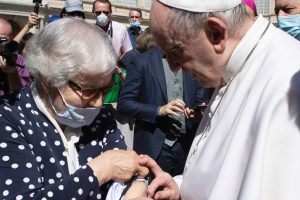For more than a decade, stories in the media have highlighted the problem of clergy sexual abuse of minors.
Much of the recent focus has been on Europe, though there have also been some particularly horrific new stories in this country, such as the one of Father Lawrence Murphy and his abuse of as many as 200 deaf boys in the residential school he ran in Wisconsin.
Most of these stories focus on the acts of offending priests and the fact that they were moved from parish to parish, ministry to ministry, continuing to allow them access to vulnerable children and youth.
Few focus on the individuals who were so gravely harmed. Yet it is they who are the heart of this unfolding, tragic story. As Archbishop Jerome Listecki of Milwaukee pointed out earlier this year, it is the courage of victims and survivors to come forward and publicly tell their stories that has made us a different church today than we were before.
As a social worker and as a member and now chair of the National Review Board, I have been privileged to listen to many stories of victims and survivors of clergy sexual abuse. I view this privilege as a sacred trust, to be received with great care and pastoral concern.
I have experienced the hearing of these individual stories as sacramental moments. They have been moments of great grace both for the survivor in the telling of the story and for me as the receiver of the story—in the connection that is made as we relate to one another.
The following are seven lessons that I and others have learned from these courageous brothers and sisters.
1. It takes great courage for a victim or survivor to come forward with his or her story after years, sometimes decades, of silence and feelings of shame. And it is crucial to them simply to be believed.
As a young adolescent, Jeanne was abused for several months by an associate pastor of her parish. She confused this priest’s attention—and her reaction to it—with being in a romantic relationship. As time went on, however, she began to have doubts about what was going on and confided in a trusted adult.
This person arranged for her to meet with the pastor, who then accused her of being responsible for having led the priest into this relationship. When her parents learned of it, they also blamed her, giving no credence to the priest’s role in initiating and maintaining the relationship. She literally had nowhere to turn.
Jeanne lived with the guilt and shame she felt, and she kept this secret about her life for nearly 30 years. She finally revealed the story to a therapist. Her relief at both telling the story and being believed after all of those years was utterly freeing, even though she still had much work to do in therapy to move toward real healing.
The feelings of guilt and shame took on an added dimension for many males who were abused by priests. As they matured emotionally and psychosexually, they experienced a struggle that centered on the question of whether what had happened to them meant that they were gay. Many eventually came to understand that they are heterosexual, and they are in successful long-term marriages today.
Even in that situation, however, the vast majority of those men personally took decades before they were able to share with their wives what had happened to them. The feelings of shame and guilt were that strong and that enduring.
On at least three occasions the individual coming forward to tell his or her story expected not to be believed. Though they had come expressly to tell their story, they expected to have to fight to be believed. Two men in their 50s to 60s broke down and cried when, after they had told their stories, I accepted it and apologized on behalf of the church for what never should have happened to them. Both expressed that it was such a relief just to be believed after all of these years.
2. Because of the violation of trust involved in abuse, some survivors trust absolutely no one to this day. Others have been able to work through this pain with the help and support of loved ones.
The issue of trust is so foundational to the emotional development of the human person that when it is seriously violated, that violation has consequences that can last a lifetime. More than one victim has told me, with no small amount of bitterness and anger, “I trust no one.”
Other survivors have had to struggle to be able to trust again, particularly when they began to develop an intimate relationship. Some were fortunate to marry spouses with the capacity to listen, to accept, and to accompany such a wounded person. Even then it often took years for real trust to flourish in their relationships.
Most poignant of all are the “before and after” pictures that a few adult survivors have shared with me. The “before the abuse” pictures are of happy, smiling children, bright-eyed, carefree, and trusting. The contrast in the “after the abuse” pictures is startling.
Gone are the bright, trusting eyes. Gone is the carefree smile of a child who anticipates that what he or she will experience in the world will be good. It is a heartbreaking experience to see such photos. Words are not necessary to describe the damage that has taken place. It is painfully obvious.
3. Many survivors have lived for years with the belief that they were “the only one” to have been abused by a particular priest.
Joe’s family had been friends with a number of their parish priests over several years. Invitations to the family home started with dinners and other family celebrations. For the most part these were healthy relationships. Until Father X.
Father X eventually became such a regular part of the family that he was included in their family vacations. By this time he had so gained the trust of this family that they thought nothing of it when he started going to Joe’s room to “tuck him in” for the night. Joe, meanwhile, was being told by Father X how “special” he was and how important it was that Joe never tell anyone about their “special friendship.”
Years later Father X’s name appeared in news stories about his sexual abuse of many boys over the years he had served as a parish priest. While he had begun to deal with his abuse in therapy, seeing the news stories was the first time Joe became aware that he was not the only boy who had been “so special” to Father X.
It was a surprise to him, of course, but it was also affirming of what he had begun to learn in therapy, namely that what had happened to him was not his fault but the fault of his abuser.
4. In spite of their own suffering, many survivors are just as concerned that the church prevents this abuse from happening to more children as they are about themselves and their own needs for healing.
This has been a real inspiration to me. It is certainly not true in every situation, but I have heard it frequently enough that it has left an impression.
After telling his story, including sharing something of the struggle to work through his issues in therapy, Mark looked me in the eye and said very directly, “In part I have come forward to share my story because I don’t want another child to have to go through all that I have gone through.”
When I have heard these or similar words, they were said with some forcefulness of voice and with some anger, stopping short of saying in so many words that “you in the church had better make sure that it doesn’t keep happening.” Those particular words may not have been there, but the message is clear, as well it should be.
5. Today there are methods of therapy that work particularly well for survivors of childhood sexual abuse, and individuals can be helped even after many years of unsuccessfully trying to simply forget about it.
Just as much has been learned over the past 20 to 30 years about the dynamics of sexual offending, much has also been learned about what it takes for individuals to begin to heal from this deep, deep wound.
For any survivor, simply telling the story is the beginning of healing. For some that first telling occurred in therapy. For others it occurred in the depth of sharing between spouses/partners. But as long as there was no telling of the story, sometimes even to oneself, healing could not begin to take place.
An entire article could be written on this topic alone. The healing journey is a long one. It does not take place in a straight line. It includes numerous ups and downs along the way. The important thing for learning this particular lesson is simply to know that help is there and that the first step is to bring into the light what has been hidden in the dark.
6. The abuse has robbed some victims of their faith. For some this has meant the loss of their Catholic faith; for others, it has meant the loss of any faith in God at all.
Ann’s was one of the most difficult stories to hear. She had been abused between the ages of 5 and 10 by an associate pastor in her parish. As a little girl she prayed daily that the abuse would stop, but it didn’t. To this day she is unable to believe in a God who loves her.
Other survivors are able to believe in God and to practice their faith, but it is no longer the Catholic faith. Still others believe in God but cannot bring themselves to practice their faith in any church.
But there are also those whose faith was able to withstand the horrors of the abuse at the time. They were able and had the desire to grow in their faith. Some of these individuals, in fact, work for the Catholic Church today as priests, deacons, and lay ministers.
7. While some victims have been unable to succeed in areas of their lives as a consequence of the great emotional harm, others have gone on to lead very healthy and productive lives.
Some survivors have struggled with addictions or with chronic, severe mental illness and have been treated, then relapsed time and time again. They have been unable to succeed in any major area of life—marriage, employment, education, parenting, and so on.
Others have done very well. They have become lawyers, judges, human-service professionals, nurses, and educators. They have benefited from treatment and are in lasting relationships. They are husbands or wives, fathers or mothers.
Between those two ends of a continuum there is as much variation as there are numbers of victims.
We still have much to learn. The individuals who have been the victims of sexual abuse by clergy and are now survivors have much to teach us: about deep and lasting pain, justified anger, the capacity to heal, courage, and the resiliency of the human spirit.
The crisis of sexual abuse of minors by clergy in the Catholic Church has affected every Catholic and devastated many lives. At the same time it holds many lessons; some of the most important come to us from the survivors themselves.
This article appeared in the January 2011 issue of U.S. Catholic (Vol. 76, No. 1, pages 34-36).













Add comment